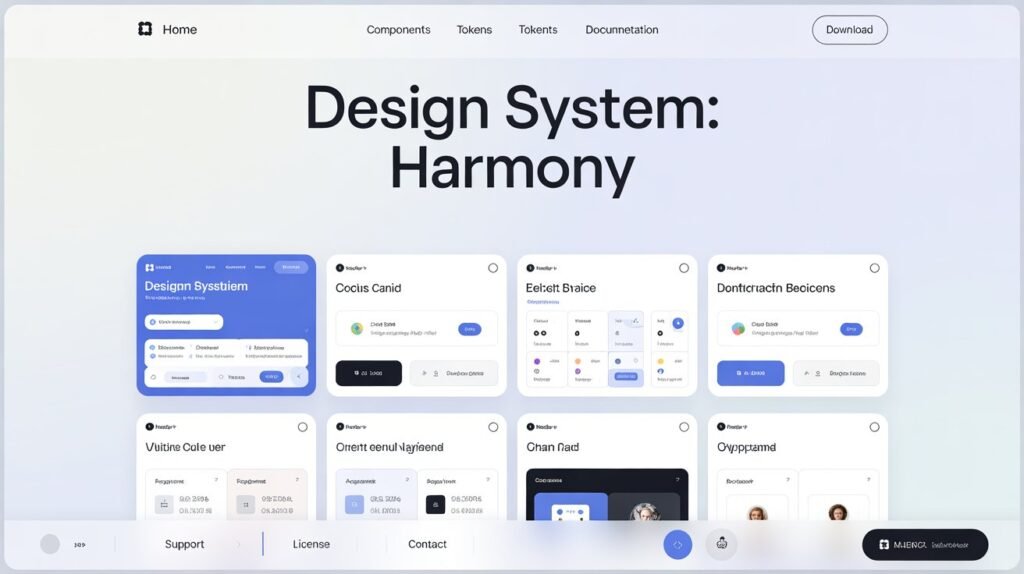
Every novice starts by asking what the fundamentals of web design are. All effective websites are built on these ideas. A well-designed website is both aesthetically pleasing and user-friendly. It provides visitors with direction, enhances their experience, and fosters trust.
People will quit a website quickly if it appears confusing. They stay longer, though, if it feels clear and smooth. You can make pages that seem contemporary, load quickly, and reach a wider audience by mastering these web design concepts. You will discover basic yet effective concepts that contribute to the effectiveness of websites in this book.
Visual Hierarchy and Layout

Visual hierarchy is about directing the eye. A page should display the most important information first. Big headings, bold fonts, and bright colors draw attention to important information, while smaller text and softer colors show supporting details. A strong layout makes it easier for users to navigate the page.
Designers frequently use grids to arrange content, and white space reduces clutter and gives breathing room. When combined, hierarchy and layout create a sense of order that makes a website easier to navigate.
Read More Web design principles for beginners
Example of Visual Hierarchy Elements
| Element | Effect on User Attention |
| Large Headings | Draw focus instantly |
| Bright Colors | Highlight key actions |
| White Space | Improves clarity |
| Grid Layout | Organizes content neatly |
Simplicity and Minimalism

Simplicity entails removing extraneous components. Users become confused by too many colors, shapes, or motions. A neat website aids in concentration and gives off a professional image.
Clarity is supported by minimalism. It means careful use of design, not blank pages. Speed, readability, and mobile usability are all enhanced by a simple design. A minimalist website guides users toward the primary objective, while a cluttered one may distract.
Consistency Across Pages

A website that is consistent is comfortable and predictable. Every page should have the same fonts, colors, and button designs. This gives users an idea of what to anticipate.
Consistent navigation is also necessary. Users become confused if a menu shifts from one page to another. Maintaining consistency facilitates the process and fosters trust. A cohesive design seems reliable and expert.
Color and Contrast

Choosing the correct color scheme establishes the personality of your website. Contrast enhances readability; dark text on a light background is easiest to read, and it also draws attention to key areas, such as call-to-action buttons. Insufficient contrast makes it difficult for users to read content.
Color and contrast play a big role in how people experience a website. Colors set the mood, while contrast makes content readable. Dark text on a light background is the easiest to read, and using accent colors for buttons or links guides users to take action.
Color and Contrast in Web Design
| Design Choice | Effect on Users |
| High Contrast Text | Improves readability |
| Accent Color on Buttons | Guides user action |
| Muted Background Tones | Adds focus to content |
| Poor Contrast | Creates accessibility issues |
Typography and Readability

People’s perceptions of your content are influenced by typography. Online reading is made easier with simple typefaces like sans-serif. Strain is avoided with appropriate font size and line spacing.
Fonts alone are not the only factor in readability. Readers can follow along more easily when there is sufficient white space, a clear structure, and short phrases. Well-designed font encourages reading, while a disorganized text block seems weighty.
Navigation and Structure
Your website’s navigation is its road map; menus, links, and buttons should all be obvious and simple to locate, allowing a visitor to access any page with a few clicks; structure arranges content; pages should make sense; well-placed menus and clear headings make it easy to navigate; and poor navigation irritates users and erodes their trust.
Accessibility and Inclusivity
Everyone, including those with impairments, can use the website if it is accessible. Simple actions that make a website accessible to everyone include captioning videos, employing high contrast colors, and adding alt language to photos.
Inclusivity extends beyond disability. It entails taking into account linguistic preferences, cultural variances, and a range of user requirements. A website that is really inclusive honors every group.
Responsiveness and Mobile-Friendly Design

Nowadays, mobile-first design is not optional; it is necessary. The majority of people browse on their phones. A responsive design makes a website adapt to all screen sizes.
Content should be readable on both large monitors and small smartphones. A mobile-friendly site loads quickly, has buttons that are easy to tap, and avoids clutter.
Mobile-Friendly Design Checklist
| Feature | Why It Matters |
| Responsive Layout | Fits all devices |
| Large Tap Targets | Easier on mobile screens |
| Fast Loading | Reduces bounce rates |
| Simple Navigation | Improves mobile experience |
Speed and Performance

These days, mobile-first design is essential; it is not an alternative. Most individuals use their phones to browse. A website that has a responsive design can adjust to any screen size.
Both small cellphones and huge monitors should be able to read the content. A mobile-friendly website eliminates clutter, features easily tapped buttons, and loads rapidly.
Content and Visual Balance

Content is the reason people visit a site. Design must support it, not overshadow it. Text, images, and videos should work together without conflict.
Visual balance is about harmony. Too many visuals can distract, while too much text feels boring. A balance of media makes the site engaging and effective.
User-Centered Design and Feedback Loops

User-centered design means creating a site for people, not for designers. Every choice must improve the visitor’s journey. Asking what users need is more important than what looks stylish.
Feedback loops keep a site updated. Analytics, surveys, and user testing show what works and what does not. A website should always evolve based on user input.
FAQ”s
Why are the basic principles of web design important?
They create a smooth and enjoyable experience that keeps users on your site longer.
What is the first principle of web design to learn?
Start with visual hierarchy because it shapes how people read and interact.
How does color impact web design?
Colors set mood, show brand identity, and guide user actions.
Can a website be good without minimalism?
A site can work, but clutter reduces clarity and focus. Minimalism improves usability.
How often should I update my website design?
Review design at least once a year. Update sooner if users face issues.
Conclusion
Now you know what are the basic principles of web design and why they matter. From hierarchy to speed, each principle makes a site better. Good design guides visitors, builds trust, and improves results. If you apply these rules, your site will not only look professional but also perform well across devices. Keep testing, keep improving, and focus on users first. That is how you create websites that last.


